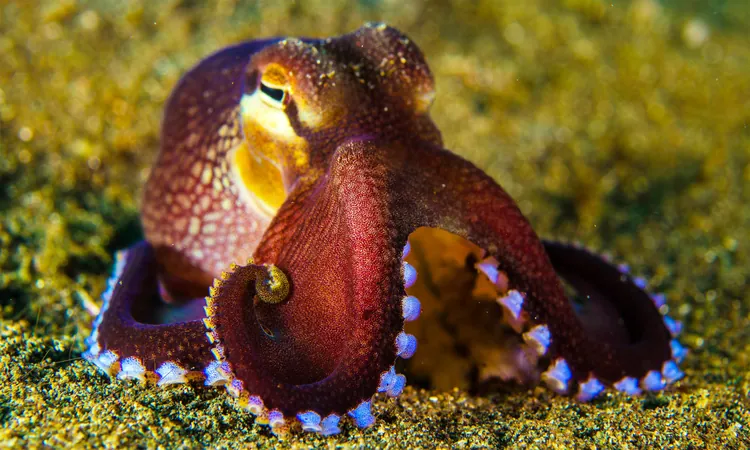
Revolutionary 'DNA Fishing' Unlocks Secrets of Deep Ocean Life
2025-04-16
Author: Liam
The Mysterious Depths of Our Planet
The deep sea is the largest habitat on Earth, yet remains one of its biggest mysteries. In this shadowy underworld, a myriad of marine creatures live in isolation, out of reach of most research tools.
Meet the Cephalopods: Nature's Intriguing Giants
Among the countless enigmatic species lurking beneath the waves, squids and octopuses—grouped as cephalopods—are particularly remarkable. Recognized for their intelligence and agility, these creatures play a crucial role in the marine ecosystem.
Studying cephalopods has traditionally been fraught with challenges, as conventional tools struggle in the abyss where these elusive beings roam, often disappearing without a trace.
A Breakthrough in Deep-Sea Exploration
A groundbreaking approach initiated by marine ecologist WU Qianqian at Kobe University promises to change the game. Her team has pioneered a method to detect cephalopods using environmental DNA (eDNA) extracted from the seawater, capturing remnants of their genetic material.
This innovative technique could redefine our understanding of deep-sea biodiversity and the ecological roles of these fascinating creatures.
Cephalopods: Keepers of the Ocean's Balance
Cephalopods are more than just remarkable specimens—they are vital to marine ecosystems. As both prey and predators, they are essential in distributing energy and nutrients throughout the ocean's food web.
Young cephalopods fall victim to fish, seabirds, and marine mammals, while adults hunt crustaceans, fish, and even their own kind, forging necessary connections between various marine environments.
Harnessing the Power of DNA
Environmental DNA refers to genetic material organisms shed into their environment. By collecting water samples and analyzing their DNA, scientists can deduce what species inhabit the area, even if the creatures themselves are hiding.
In her latest study, Wu's team created targeted primers focused on specific genetic markers to isolate and identify squids (Decapodiformes) and octopuses (Octopodiformes). This eDNA metabarcoding technique allows the amplification of multiple species’ DNA from single samples.
The Success Story of the New Primers
Designing these primers was a meticulous process; the team needed to ensure they were broad enough to detect all cephalopods while avoiding unrelated species. Their consistency and reliability in both laboratory and deep-sea environments marked a significant feat.
Tests showed the primers could identify cephalopods of varying sizes, from the tiny Heteroteuthis dagamensis to the massive Architeuthis dux, across different depths of the ocean.
Unveiling Hidden Biodiversity
This research exemplifies the potential of the new technique. Water samples taken from the surface down to 2,000 meters unveiled cephalopod species previously unidentified in Japanese waters. This not only uncovers hidden biodiversity, but also fills in gaps in our understanding of regional marine life.
A particularly intriguing finding was that octopus DNA was solely located in the deepest samples, providing insights into their solitary and ground-dwelling behavior.
Understanding Behavior Through DNA
The capability to track marine animals via DNA also translates to understanding their behavior. Wu indicates future studies will refine their sampling strategies based on the life cycle and habits of different cephalopod species.
The DNA findings suggest that while squids travel through the water, octopuses prefer to stay hidden among the seabed.
A New Era for Ocean Research
Despite promising advancements, challenges persist, particularly regarding reference databases for accurate species identification. Wu emphasizes the need for collaboration among molecular biologists and taxonomists to eliminate misidentifications.
Looking ahead, Wu's technique is set to revolutionize deep-sea cephalopod research and serve as a cornerstone for marine life conservation efforts.
By uniting eDNA metabarcoding with targeted primer design, the team has created a non-invasive methodology for tracking cephalopods. This groundbreaking work lays a strong foundation for future explorations into marine biodiversity, population dynamics, and ecosystem health.
As human impact on the oceans increases, these sophisticated DNA tools become vital for understanding and protecting the marine life that remains shrouded in mystery.









 Brasil (PT)
Brasil (PT)
 Canada (EN)
Canada (EN)
 Chile (ES)
Chile (ES)
 Česko (CS)
Česko (CS)
 대한민국 (KO)
대한민국 (KO)
 España (ES)
España (ES)
 France (FR)
France (FR)
 Hong Kong (EN)
Hong Kong (EN)
 Italia (IT)
Italia (IT)
 日本 (JA)
日本 (JA)
 Magyarország (HU)
Magyarország (HU)
 Norge (NO)
Norge (NO)
 Polska (PL)
Polska (PL)
 Schweiz (DE)
Schweiz (DE)
 Singapore (EN)
Singapore (EN)
 Sverige (SV)
Sverige (SV)
 Suomi (FI)
Suomi (FI)
 Türkiye (TR)
Türkiye (TR)
 الإمارات العربية المتحدة (AR)
الإمارات العربية المتحدة (AR)